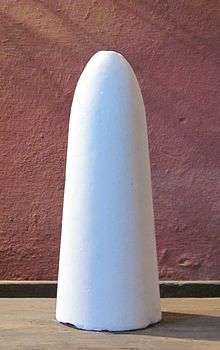
Great Sugar Loaf
The Great Sugar Loaf (Irish: Ó Cualann or Beannach Mhór), also known as the Big Sugar Loaf and often as simply the Sugar Loaf, is a hill in east County Wicklow in Ireland.
Geography
The mountain is located between Delgany and Kilmacanogue, and just to the north of the Glen of the Downs Nature Reserve. The smaller Little Sugar Loaf lies across the N11 road, to the east.
Though only 501 metres (1,644 ft) high, the Great Sugar Loaf's isolation from other hills, steep slopes and volcanic appearance makes it appear much taller than it is. Due to its height relative to the surrounding landscape, the hill qualifies as a Marilyn.
Geology
The Great Sugar Loaf is composed of Cambrian quartzite, in contrast to the rounded mountains to the west, which are made of Devonian granite. Popularly mistaken for a volcano, it is in fact an erosion-resistant metamorphosed sedimentary deposit from the deep sea.
References
See also
Gallery

The rocky, steep slopes of the Great Sugar Loaf.

Sugarloaf
A sugarloaf was the usual form in which refined sugar was produced and sold until the late 19th century, when granulated and cube sugars were introduced. A tall cone with a rounded top was the end-product of a process that saw the dark molasses-rich raw sugar, which was imported from sugar cane growing regions such as the Caribbean and Brazil, refined into white sugar.
History
The earliest record to date appears to be 12th century in Jordan, though reference to a cone of sugar is found in al-Zubayr ibn Bakkar's 9th century Arabic Al-Akhbar al-Muwaffaqiyyat. In Europe, they were made in Italy from 1470, Belgium 1508, England 1544, Holland 1566, Germany 1573 and France 1613. When refining from sugar beet began in mainland Europe in 1799, loaves were produced in the same way and are still common in some parts, especially in Germany, where small loaves are a required ingredient for the Christmas season drink Feuerzangenbowle.
Until the mid-19th century, the British government used a system of punitive taxes to make it impossible for its colonial producers in the Caribbean to refine their own sugar and supply Britain with finished sugarloaves. Previously the Amsterdam industry had been similarly protected from the importation of East India white sugar. Instead, a dark raw sugar or muscovado, produced on the plantations by initial boilings of the fresh cane juice, was shipped in hogsheads to Europe on what was the third leg of the Triangular Trade.

Capotain
A capotain, capatain or copotain is a tall-crowned, narrow-brimmed, slightly conical "sugarloaf" hat, usually black, worn by men and women from the 1590s into the mid-seventeenth century in England and northwestern Europe. Earlier capotains had rounded crowns; later, the crown was flat at the top.
The capotain is especially associated with Puritan costume in England in the years leading up to the English Civil War and during the years of the Commonwealth. It is also commonly called a Flat Topped Hat and a Pilgrim hat, the latter for its association with the Pilgrims that settled Plymouth Colony in the 1620s. Contrary to popular myth, capotains never included buckles on the front of them; this image was created in the 19th century.
Gallery

England, 1592
England, 1592

England, 1600s
England, 1600s

Holland, 1615
Holland, 1615

Flanders, 1630s
Flanders, 1630s

England, 1640s
England, 1640s
Further reading
Sugarloaf (disambiguation)
A sugarloaf is refined sugar in the form of a rounded cone, the most common way of distributing sugar until the late 19th century.
Sugarloaf or Sugar Loaf may also refer to:
Geographic features
Communities
Locations
Podcasts:

Latest News for: great sugar loaf
- 1
